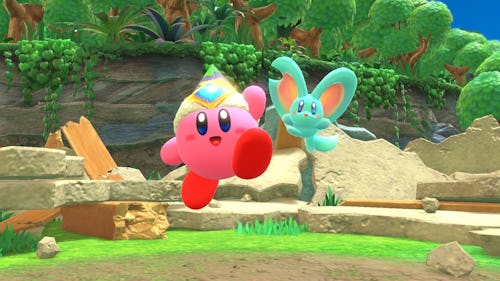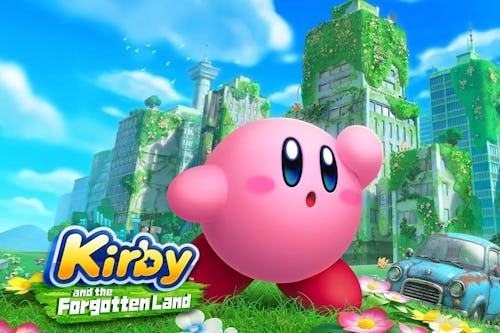
Describing the state of the world as “dystopian” has become commonplace in the last half-decade or so (for good reason!). One place I never expected to apply it: a new Kirby game. And yet here we are.
Nearly all of Kirby and the Forgotten Land for the Nintendo Switch takes place in New World, a land that has been, well, forgotten. It is post-apocalyptic in an abstract sense; some force has torn its structures asunder, its inhabitants nowhere to be found. To make matters significantly worse, all of the Waddle Dees have been captured by a company of evil animals called the Beast Pack.
The setting is, yes, dystopian, a twist somewhat darker than past Kirby games — the kind of Kirby world that could only be produced amongst such malevolent events happening in the real world. It also sets the scene for a platformer that is, for once, not simply about moving from Point A to Point B while racking up as little damage as possible. Forgotten Land is a platformer about discovery, both of expansive spaces and of the hidden treats that lie within them. (And they are treats, truly — Kirby’s appetite for delicious food has not abated.)
Input may receive a portion of sales if you purchase a product through a link in this article. We only include products that have been independently selected by Input's editorial team.

3D pop

Your goal as Kirby is to trek through New World and save all the Waddle Dees. Your journey to do so is split into stages, each of which has a theme and multiple stages that fit said theme. This gameplay structure will feel familiar to just about anyone who’s played a mainline Kirby game in the past. Get to the end of a stage and you’re rewarded with the freedom of a handful of Waddle Dees.
The overarching lore here isn’t very complicated; even the game’s most pressing questions generally take the back seat as you’re powering through each area of New World. That’s for the best, really, because the story is not what matters here. It’s just cohesive enough to hold together the drive behind your journey — and to provide a simple but motivating reward system as you move through the game.
Forgotten Land adds a number of new elements to the tried-and-true Kirby formula, not the least of which is the game’s bright, round 3D animation. The game’s refreshed 3D style is as playful as ever, though at times it feels distinctly last-gen. Close-up textures are often messy and lack detail — issues that stand out all the more given Kirby and his foes’ clean animations. These graphical shortcomings are not uncommon for Switch games; the Switch — now a 5-year-old console — was not designed to be a polygon powerhouse. In true Nintendo fashion, Forgotten Land emphasizes entertaining gameplay over high-res pixels.
New World
Then there’s Waddle Dee Town, which operates both as its stated purpose (a home for all the Waddle Dees you’ve rescued) and a hub for all the game’s extras. The number of activities you can spend time on in Waddle Dee Town is directly related to how many Waddle Dees you’ve saved; it lends an extra sense of progression to the game. Once the town colosseum opens up, for example, you can fight in tournaments against the bosses you’ve already faced.

Waddle Dee Town is also where you’ll find the Weapon Shop — one of the most useful additions to Forgotten Land. Collect “blueprints” as you traverse New World and the Weapon Shop will give you the option to upgrade your copy abilities. Kirby’s greatest power has always been consuming enemies to absorb their abilities, but now those powers can actually evolve into more powerful and nuanced versions of themselves. The Fire ability, for example, becomes Volcano Fire. This effectively adds 24 new copy abilities to the game, each a joy to play around with.
There is one caveat to the joy brought to Forgotten Land by the Weapon Shop: You’ll need to play through many mini-games to upgrade all your copy abilities. The shop owner demands both Star Coins (obtained through normal play) and Rare Stones to upgrade each ability — and the latter can only be obtained by playing through side puzzles. Each is designed to test your skill with a given ability and, yes, many of them are enjoyable enough. The problem is that exploring the main levels is so much more fun. Being forced to take breaks from that exploration to complete relatively simplistic puzzles can feel like more of a drag than anything else.

The game’s main level structure really is where it shines. Though many times you are ushered toward your main goal — simply making it to the end without losing all your health — the game does encourage a fair amount of organic exploration. Hidden nooks provide opportunities to free more Waddle Dees, as well as collectible figurines, Star Coins, and copy ability blueprints. It’s far from the open-world structure that’s en vogue as of late, and that’s for the best. These landscapes hold gems for both the casual player and the completionist to find joy in.
Mouthful Mode is... the most entertaining addition to the Kirby series in many years.
And then there’s Mouthful Mode. The new ability, whereby Kirby can essentially hold inanimate objects in his mouth to possess new powers, is by far the most entertaining addition to the Kirby series in many years. Some Mouthful abilities are straightforward (take a car in your mouth to drive it) while others (swallow a vending machine to break walls with soda cans) are more ridiculous. Using Mouthful Mode becomes a necessity in completing many levels; even as you’re gawking at how strange Kirby looks in the shape of a lightbulb, you find that shedding light on the world around you is actually very useful.

This, really, is where Kirby as a franchise has always shined brightest. It’s a series that doesn’t worry itself too much with being serious, throwing conventional stakes out in favor of silliness. As far as Nintendo’s platformers go, Kirby games are known for being some of the easiest, and that’s exactly why they work so very well. That’s not to say there aren’t stakes involved — Kirby can certainly die — but finding new creative ways to bash enemies without real stress is a Kirby hallmark.
Here, more than ever, the franchise’s prioritizing of levity over seriousness is a boon to the game’s general success. Some features exist in Forgotten Land simply because they’re cute or entertaining. Take, for example, Kirby’s house in Waddle Dee Town, which allows users to rest up and recover health points. Does Kirby’s fully furnished room fulfill any deeper purpose for in-game progress? Nope — you can’t even decorate it. Or what about the collectible figurines you can grab from the gumball machine down an alleyway? Not even a little bit. Sometimes a secret pathway leads to a hidden Waddle Dee; sometimes it leads to a single bottle of soda. There’s some sense that meaningless is the point here, that not every aspect of Forgotten Land needs to add up. It’s comforting, somehow.

Kirby reborn
Overall, though, Forgotten Land really does comprise a whole that’s greater than the sum of its parts. The core mechanics here just work so well together. Adding a third dimension to a classic platformer is by no means an easy feat, but the Kirby team has done it in an exemplary manner. The game’s take on perspective as Kirby maneuvers through each level is playful and intentional; by relinquishing camera controls to the developers, Forgotten Land is able to maintain that classic platformer feel without actually existing in just two dimensions. This is complemented greatly by the game’s plethora of level locales, each of which provides plenty of opportunity for well-framed, cinematic shots.
Putting Kirby in such post-apocalyptic, oft-familiar spaces lends a twisted sense of wonder.
Forgotten Land’s hook is that it replaces previous games’ cheery, pastoral locations with a world that’s a shell of its former self; the more urban locations are particularly grim, though riding an abandoned escalator to the dirty food court does have a unique charm. Putting Kirby in such post-apocalyptic, oft-familiar spaces lends a twisted sense of wonder to a series so grounded in fantasy. And yet the game still manages to be relentlessly bright and cheerful. There’s genuine hope here, presented in a way not many franchises can master.








